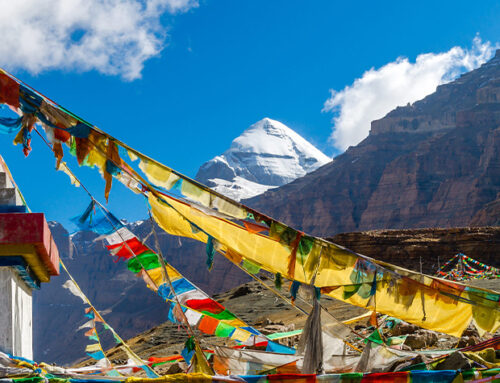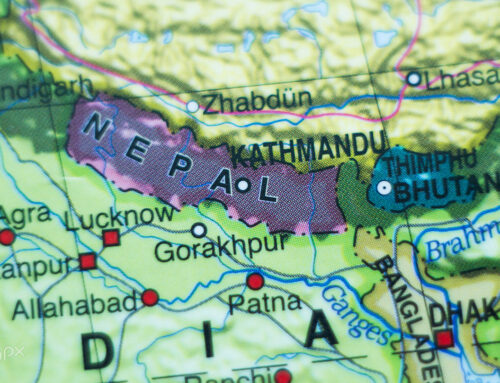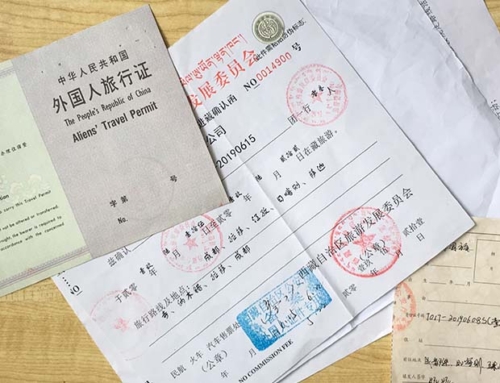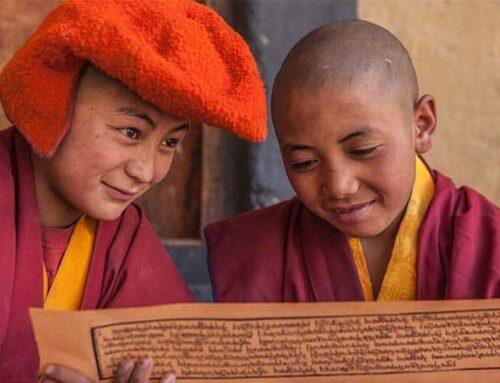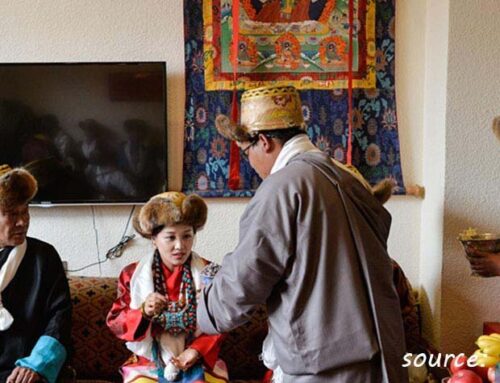As a Tibetan professional tour operator in Tibet, I would like to provide you with a brief overview of Tibetan culture and the importance of greetings in Tibetan society. In Tibetan culture, greetings are more than just a formality – they are an essential part of daily life and social interactions.
Tibetan society places a high value on respect and hospitality, and one way that this is demonstrated is through the use of greetings. Whether it’s a simple “tashi delek” (hello) or a more elaborate greeting that involves offering a khata (traditional Tibetan scarf), greetings are a way to show respect and build connections with others.
In this blog post, We will explore the different types of Tibetan greetings, their meanings, and how they are used in various social settings. Whether you are planning a trip to Tibet or simply interested in learning more about this fascinating culture, this blog post will provide you with valuable insights into Tibetan greetings and their significance.
So, let’s dive in and explore the wonderful world of Tibetan greetings together!

History and Significance of Tibetan Greetings
Tibetan greetings have a long and rich history, and are an essential part of Tibetan culture and daily life. There are various types of Tibetan greetings, including verbal, physical, and spiritual, each with its own unique significance.
Verbal greetings in Tibetan culture often involve the use of honorific language, which demonstrates respect and shows that the speaker recognizes the other person's status and importance. Physical greetings, such as offering a khata or bowing, are also common in Tibetan culture and are used to show respect and build connections with others.
In addition to their social significance, Tibetan greetings also have a deep spiritual and religious meaning. Tibetan Buddhism emphasizes the importance of compassion, wisdom, and mindfulness, and these values are reflected in Tibetan greetings. For example, when offering a khata, the color and direction of the scarf are important and hold symbolic significance. The act of giving and receiving a khata is also seen as a way to generate positive karma and cultivate compassion.
Furthermore, Tibetan greetings are deeply connected to Buddhist philosophy and practice. The Tibetan word for greeting, "tashi delek," is derived from the Sanskrit word "tashi dele," which means "auspiciousness and happiness." By greeting others with this phrase, Tibetans express their wish for the other person's happiness and well-being, in accordance with Buddhist teachings.
Overall, the history and significance of Tibetan greetings are rooted in Tibetan culture, religious beliefs, and values. Understanding the importance of these greetings can help visitors to Tibet better appreciate and connect with the local culture and people.
Types of Tibetan Greetings
Tibetan greetings can be categorized into three main types: verbal greetings, physical greetings, and spiritual greetings.
Verbal greetings are common phrases and expressions used in the Tibetan language to greet people in different situations. Some examples include "Tashi Delek" which means "Good luck" or "Kamsang" which means "Wellbeing of all dimension of existance". These greetings are often used in everyday conversation, and show respect and politeness towards others.
Physical greetings are traditional gestures used to show respect and affection, such as bowing, prostrating, and hand gestures. Bowing is a common way of greeting elders, lamas, and other respected individuals. Prostrating involves kneeling down and touching one's forehead to the ground, and is a way of showing utmost respect and humility. Hand gestures are also used to greet people in different situations, such as offering a khata (traditional scarf) as a sign of respect and goodwill.
Spiritual greetings are rituals and practices used to honor the Buddha and other spiritual beings, including chanting, offerings, and prayers. These greetings are often performed in monasteries and temples, and involve elaborate ceremonies that require special knowledge and training.
Understanding the different types of Tibetan greetings is important for visitors to Tibet, as it shows respect for the local culture and customs.
Cultural Etiquette for Tibetan Greetings
In Tibetan culture, greetings are an important part of daily life and are deeply connected to social customs and traditions. When greeting someone in Tibet, it is important to be aware of the appropriate behavior and language for different situations.
When greeting someone of a different gender, it is customary to show respect by using formal language and avoiding physical contact. For example, when greeting an older woman, it is appropriate to use the honorific title "Ama," which means "mother" in Tibetan.
When greeting someone of a higher social status, it is important to show deference and respect. This can be done through the use of honorific titles, such as "La", as well as through appropriate body language, such as bowing or prostrating.
There are also some common mistakes to avoid when greeting Tibetans. It is considered disrespectful to touch someone's head, as the head is considered sacred. Additionally, it is important to avoid giving inappropriate gifts, such as items made from leather or alcohol, as these are considered impure in Tibetan culture.
By following these cultural etiquette guidelines, you can show respect and appreciation for Tibetan customs and traditions when greeting people in Tibet.
Benefits of Learning Tibetan Greetings when traveling to Tibet
Learning Tibetan greetings is an essential part of understanding Tibetan culture and building positive relationships with locals. By showing respect and appreciation for their traditions, you can deepen your cultural understanding and connect more deeply with the Tibetan people.
Knowing Tibetan greetings can also help to promote intercultural communication and understanding. When you learn to communicate in the local language, you can break down barriers and build bridges of understanding between different cultures.
Practicing Tibetan greetings can also be a rewarding personal growth experience. By stepping outside of your comfort zone and learning new ways of communication, you can develop greater empathy and openness towards people from different backgrounds.
Additionally you can learn 100 Basic Tibetan Phrases
Here are some practical tips for practicing and integrating Tibetan greetings into daily life:
- Learn some basic Tibetan phrases and practice them with locals.
- Observe the appropriate behavior and language when greeting people of different genders, ages, and social status.
- Avoid common mistakes, such as touching someone's head or giving inappropriate gifts.
- Embrace the opportunity to learn from locals and deepen your cultural understanding.
FAQ of Tibetan Greetings
Q: What are some common Tibetan greetings?
A: Some common Tibetan greetings include "Tashi delek" (meaning "auspicious blessings"), "Kuzu zangpo" (meaning "hello" or "how are you?"), and "Jullay" (a casual greeting used among friends and younger people).
Q: Why are Tibetan greetings important?
A: Tibetan greetings are an important aspect of Tibetan culture, reflecting the values of respect, hospitality, and compassion. They also serve as a way to connect with others and build relationships.
Q: What is the proper way to greet someone in Tibet?
A: The proper way to greet someone in Tibet depends on the context and the relationship between the greeter and the person being greeted. Verbal greetings such as "Tashi delek" or "KamSang" are common, as are physical gestures like bowing or hand gestures. It is important to be aware of cultural etiquette and show respect towards elders and people of higher social status.
Q: Can foreigners learn Tibetan greetings?
A: Yes, foreigners can learn Our greetings and it is highly encouraged to do so as a way of showing respect and cultural understanding when visiting Tibet.
Q: Are there any gestures or actions to avoid when greeting someone in Tibet?
A: Yes, there are certain gestures and actions to avoid when greeting someone in Tibet, such as touching someone's head or giving inappropriate gifts. It is important to be aware of cultural etiquette and show respect towards elders and people of higher social status.
Q: How can learning Tibetan greetings enhance my travel experience in Tibet?
A: Learning Tibetan greetings can enhance your travel experience in Tibet by facilitating communication and building relationships with locals. It also shows respect towards Tibetan culture and can deepen your understanding of the customs and values of the region.
The best way to learn the Tibetan Greetings is by observing your tour guide and asking him/her about it.
Conclusion of Tibetan Greetings
In conclusion, Tibetan greetings are an important aspect of Tibetan culture, rooted in tradition, spirituality, and social norms. We've covered the history, significance, and different types of Tibetan greetings, as well as cultural etiquette and the benefits of learning them.
As a Tibetan professional tour operator, We encourage readers to try learning and using Our greetings in their daily lives, not only as a way to show respect and appreciation for Tibetan culture but also as a means of promoting intercultural communication and understanding.
By incorporating Our greetings into our interactions with others, we can build bridges of empathy and connection across different cultures and backgrounds. So why not give it a try? Next time you meet someone, try saying "Tashi Delek" and see how it feels.
About Tibet Travel & Tours
Tibet Travel & Tours is a local travel agency in Tibet that offers unique and authentic experiences to travelers from all around the world. As a leading tour operator in Tibet, we provide high-quality Tibet Travel services that are tailored to our clients' needs and preferences.
Our team of experienced and knowledgeable professionals strives to ensure that our clients have a hassle-free and memorable trip in Tibet. We specialize in various types of tours, including cultural tours, trekking and hiking tours, and adventure tours.
Our commitment to providing exceptional service has earned us a reputation as one of the best local travel agencies in Tibet. Contact us today to plan your unforgettable trip to Tibet. You can also check out out Tibet travel blog: Nomadic Tibet
Explore Tibet with a local Tibetan Travel Agency
If you're looking to explore Tibet, starting your journey with a reputable Tibetan travel agency in Tibet is crucial. Tibet Travel & Tours is a great choice to begin your adventure with their extensive knowledge of the region and commitment to responsible tourism.
Their Tibet tour packages cater to a range of interests and budgets, making it easy to plan a trip that suits your needs. Before embarking on your tibet tour, it's essential to have the right Tibet travel information and necessary documents, including a Tibet travel permit.
The Tibet Travel Planner provided by i-Tibet travel is an excellent resource to plan your trip, including tips on what to pack, where to stay, and what to see.
For beginners, the "About Tibet" guide provided by i-Tibet travel offers a comprehensive overview of the region's history, culture, and top attractions. So, start your Tibet travel plan here with i-Tibet travel and discover the magic of Tibet for yourself.


